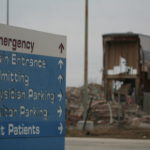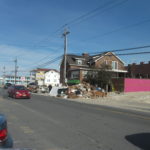Just nine days ago, on November 15, I stood in front of two successive audiences of long-term health care practitioners to present workshops at a conference in Wisconsin Dells discussing, of all things, “Fundamentals of Planning for Post-Disaster Recovery.” Where, some might ask, is the nexus between these two subjects?
Patients who survived evacuations from New York City area hospitals, six in the city itself and one just outside, during Hurricane Sandy would know. People with disabilities, the elderly, the ill are especially vulnerable during disasters, and moving them out of harm’s way is no picnic. They cannot just grab the keys to their cars and drive out of town ahead of the storm. Evacuating them is a major undertaking that must be well-planned.
And so, our fields of expertise converged. I discussed what I knew from urban planning, but I invited input from their experiences in handling such situations. Some had not yet experienced a disaster, but others had, and their numbers in the health care field are growing, as doctors and nurses find clinics and hospitals impacted by wildfires in California, and hurricanes, floods, and tornadoes elsewhere. Mine was not the only presentation related to such concerns. The keynote by Desiree Matel-Anderson, founder of the Field Innovation Team and a Federal Emergency Management Agency (FEMA) advisor, detailed personal interactions with disasters. Others focused on emergency management. The audience needed to know about new regulations and laws, such as those promulgated in 2016 by the Centers for Medicare and Medicaid Services (CMS) or the Disaster Recovery Reform Act (DRRA), passed in October as a
rider on the FAA Reauthorization Act. DRRA outlines new responsibilities for the FEMA administrator in providing training to local officials and utility providers in planning for emergencies for nursing homes, clinics, and hospitals, and for the Federal Highway Administration regarding evacuations for these facilities, prisons, and certain classes ofdisadvantaged persons. I told the nurses and administrators in my audience they needed to prepare for these new responsibilities. There seems to be a growing conviction in Congress and federal agencies that health care institutions need to be better prepared to protect their patients during disasters. In the light of events dating back to Hurricane Katrina, that does not seem unreasonable.
To some extent, I believe it is the growing engagement of the urban planning profession with natural hazards that is facilitating a re-engagement of the profession with public health practitioners. I say “re-engagement” because the two fields grew up together, at least in North America. In the late 1800s and early 1900s, industrializing, rapidly growing American cities were often festering incubators for diseases because of pollution, overcrowding, and fire and other hazards. The Great Chicago Fire of 1871 laid the groundwork for major reforms related to building codes, helping to create the largely masonry-based architecture now predominant in the city. Activists like Jane Addams inveighed against oppressive health conditions for the working class. There was an urgent need for both better planning and public health measures that would prevent the spread of disease, and the two professions matured accordingly. At the same time, civil engineers took growing responsibility for developing the sanitary infrastructure cities needed, such as sewer treatment systems and effective drainage, a topic I addressed in a keynote in September 2015 in Boston for the American Society of Civil Engineers’ Coasts, Oceans, Ports and Rivers Institute (COPRI) annual conference. All three professions grew up in the same cradle, addressing urgent societal needs for health care, better urban design, and public sanitation.
All of this is a long, but I think crucial, introduction to a book by Michael R. Greenberg and Dona Schneider, Urban Planning & Public Health: A Critical Partnership, published by APHA Press. I had planned to review it earlier, but recent events expanded the context for its importance. Greenberg, a long-time planning colleague and professor at Rutgers University in New Jersey, previously authored Protecting Seniors Against Environmental Disasters (Routledge, 2014), a book inspired in part by his own experience with elderly parents during Hurricane Sandy. He is certainly familiar with the territory. Schneider, also at Rutgers, brings the perspective of a public health expert.
The book reads mostly like a textbook and thus may be of most valuable to instructors willing to acquaint students in both fields with their organic relationship to each other and why the partnership is important today. Admittedly, the problems are not the same. We no longer face the scourge of tuberculosis, and smokestacks no longer belch particulates as freely as they once did. The water is less polluted. But our society is creating other problems of a momentous nature, including climate change and the resulting increased severity of weather-related disasters. Under the Trump administration and various less environmentally friendly state administrations, there have been concerted efforts to retreat from previous initiatives aimed to clear the skies and foster environmental justice. It is thus imperative that we have trained, knowledgeable, and articulate professionals who can advocate for the public interest when powerful political forces push in other directions.
The book makes powerful arguments in this context for the salience of a collaborative assault on the threats posed to our communities by natural hazards, using the tools of both public health and planning to analyze the threats and identify meaningful solutions. Not everything needs to happen at a macro level, either; in fact, planners and public health officials often are at their best in examining trends at the neighborhood and community level to find very geographically specific solutions to localized but persistent problems.
The authors are methodical, laying a groundwork in the first three chapters for understanding the building blocks of the two professions and their integral relationships. One can easily detect the influence of Greenberg’s long and distinguished career on both a practical and theoretical level as he discusses the impacts of various approaches to zoning, such as the use of downzoning to protect open lands and natural resources and the use of special districts, as in Austin, Texas, to protect the environmentally sensitive Edwards Aquifer through measures such as integrated pest management practices, which reduce the use of toxic chemicals that can enter the water supply. And the connection to natural disasters? Even recent history has revealed the vulnerability of Texas to prolonged drought, making the protection of water supplies essential to public health and welfare.
Recognizing the modern context for their focus on this “critical partnership,” the authors have included significant material on the role of risk and hazard mitigation analysis in planning, with a whole chapter on “Keeping People Out of Harm’s Way.” As with much of the book, it leads students on a path through the critical minutiae of planning and public health analysis, including case studies at various levels of analysis—for example, a brief but close look at the Galveston City Hazard Mitigation Plan.
Other sections address critical current issues such as the availability of healthy foods in poor communities, and how that can be addressed through laws, community organizations, and better resources; how to redevelop safe community assets from former brownfield sites; and potentially evaluating the benefits and drawbacks of major regional development proposals. In short, this is not bedtime reading for most laypeople, but it is solid instructional material for aspiring young professionals and may be useful as well to community advocates who are willing to learn the nuts and bolts of using planning to achieve better public health results in their neighborhoods and communities. As such, it is a timely and needed addition to the literature.
Jim Schwab

